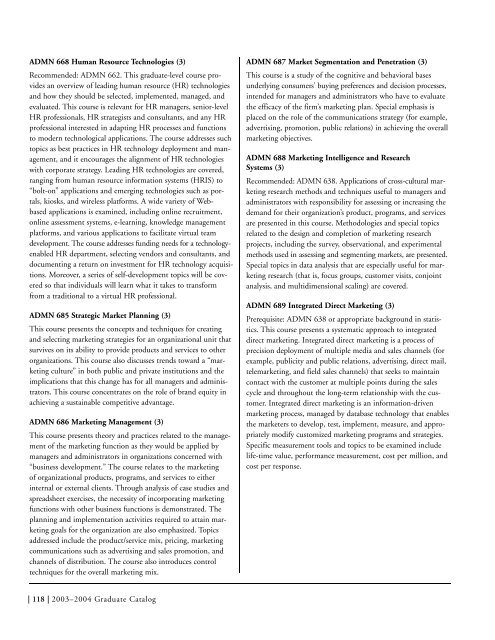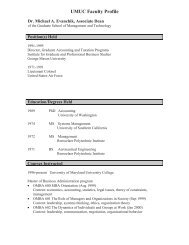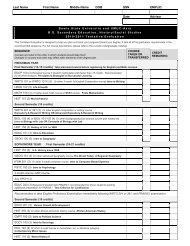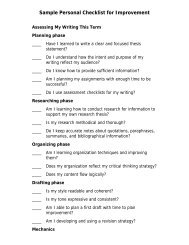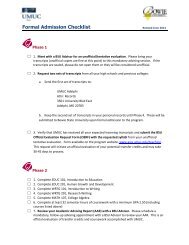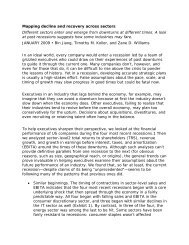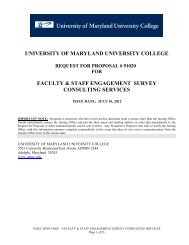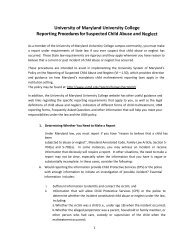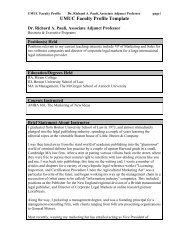A+B. Intro_SJ.1 - University of Maryland University College
A+B. Intro_SJ.1 - University of Maryland University College
A+B. Intro_SJ.1 - University of Maryland University College
Create successful ePaper yourself
Turn your PDF publications into a flip-book with our unique Google optimized e-Paper software.
ADMN 668 Human Resource Technologies (3)<br />
Recommended: ADMN 662. This graduate-level course provides<br />
an overview <strong>of</strong> leading human resource (HR) technologies<br />
and how they should be selected, implemented, managed, and<br />
evaluated. This course is relevant for HR managers, senior-level<br />
HR pr<strong>of</strong>essionals, HR strategists and consultants, and any HR<br />
pr<strong>of</strong>essional interested in adapting HR processes and functions<br />
to modern technological applications. The course addresses such<br />
topics as best practices in HR technology deployment and management,<br />
and it encourages the alignment <strong>of</strong> HR technologies<br />
with corporate strategy. Leading HR technologies are covered,<br />
ranging from human resource information systems (HRIS) to<br />
“bolt-on” applications and emerging technologies such as portals,<br />
kiosks, and wireless platforms. A wide variety <strong>of</strong> Webbased<br />
applications is examined, including online recruitment,<br />
online assessment systems, e-learning, knowledge management<br />
platforms, and various applications to facilitate virtual team<br />
d e velopment. The course addresses funding needs for a technologyenabled<br />
HR department, selecting vendors and consultants, and<br />
documenting a return on investment for HR technology acquisitions.<br />
Moreover, a series <strong>of</strong> self-development topics will be covered<br />
so that individuals will learn what it takes to transform<br />
from a traditional to a virtual HR pr<strong>of</strong>essional.<br />
ADMN 685 Strategic Market Planning (3)<br />
This course presents the concepts and techniques for creating<br />
and selecting marketing strategies for an organizational unit that<br />
survives on its ability to provide products and services to other<br />
organizations. This course also discusses trends toward a “marketing<br />
culture” in both public and private institutions and the<br />
implications that this change has for all managers and administrators.<br />
This course concentrates on the role <strong>of</strong> brand equity in<br />
achieving a sustainable competitive advantage.<br />
ADMN 686 Marketing Management (3)<br />
This course presents theory and practices related to the management<br />
<strong>of</strong> the marketing function as they would be applied by<br />
managers and administrators in organizations concerned with<br />
“business development.” The course relates to the marketing<br />
<strong>of</strong> organizational products, programs, and services to either<br />
internal or external clients. Through analysis <strong>of</strong> case studies and<br />
spreadsheet exercises, the necessity <strong>of</strong> incorporating marketing<br />
functions with other business functions is demonstrated. The<br />
planning and implementation activities required to attain marketing<br />
goals for the organization are also emphasized. Topics<br />
addressed include the product/service mix, pricing, marketing<br />
communications such as advertising and sales promotion, and<br />
channels <strong>of</strong> distribution. The course also introduces control<br />
techniques for the overall marketing mix.<br />
ADMN 687 Market Segmentation and Penetration (3)<br />
This course is a study <strong>of</strong> the cognitive and behavioral bases<br />
underlying consumers’ buying pre f e rences and decision pro c e s s e s ,<br />
intended for managers and administrators who have to evaluate<br />
the efficacy <strong>of</strong> the firm’s marketing plan. Special emphasis is<br />
placed on the role <strong>of</strong> the communications strategy (for example,<br />
advertising, promotion, public relations) in achieving the overall<br />
marketing objectives.<br />
ADMN 688 Marketing Intelligence and Research<br />
Systems (3)<br />
Recommended: ADMN 638. Applications <strong>of</strong> cross-cultural marketing<br />
research methods and techniques useful to managers and<br />
administrators with responsibility for assessing or increasing the<br />
demand for their organization’s product, programs, and services<br />
are presented in this course. Methodologies and special topics<br />
related to the design and completion <strong>of</strong> marketing research<br />
projects, including the survey, observational, and experimental<br />
methods used in assessing and segmenting markets, are pre s e n t e d .<br />
Special topics in data analysis that are especially useful for marketing<br />
research (that is, focus groups, customer visits, conjoint<br />
analysis, and multidimensional scaling) are covered.<br />
ADMN 689 Integrated Direct Marketing (3)<br />
Prerequisite: ADMN 638 or appropriate background in statistics.<br />
This course presents a systematic approach to integrated<br />
direct marketing. Integrated direct marketing is a process <strong>of</strong><br />
precision deployment <strong>of</strong> multiple media and sales channels (for<br />
example, publicity and public relations, advertising, direct mail,<br />
telemarketing, and field sales channels) that seeks to maintain<br />
contact with the customer at multiple points during the sales<br />
cycle and throughout the long-term relationship with the customer.<br />
Integrated direct marketing is an information-driven<br />
marketing process, managed by database technology that enables<br />
the marketers to develop, test, implement, measure, and appropriately<br />
modify customized marketing programs and strategies.<br />
Specific measurement tools and topics to be examined include<br />
life-time value, performance measurement, cost per million, and<br />
cost per response.<br />
| 118 | 2003–2004 Graduate Catalog


